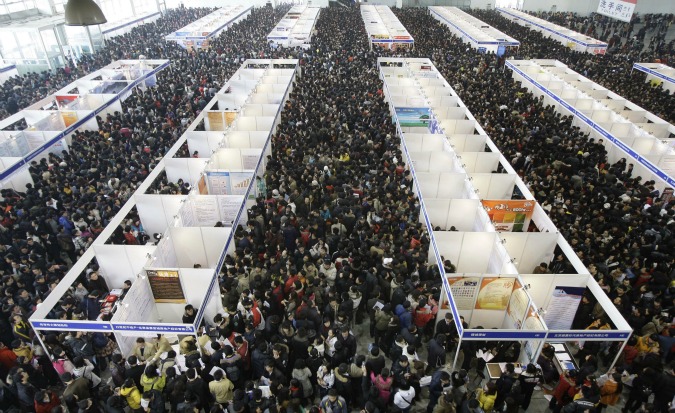
US Research Cuts Drive Top Chinese Scholars Home, Creating Fierce Competition and Opportunities for Western Companies
A Flood of Brains: As U.S. Withdraws Research Funding, China Faces an Academic Talent Glut
A Reverse Exodus Reshapes Global Research Power—But Not Without Turbulence at Home
In a crowded seminar room at a top university in China earlier this month, three returning Ph.D. graduates from MIT, Stanford, and UC Berkeley took turns presenting their latest research to a standing-room-only audience. The tension was palpable. Not because of academic competition, but because each knew their odds of landing a permanent research post were rapidly shrinking both in the US and in China.

Across China, the academic job market is being upended—not by brain drain, but by brain return. The reversal of a decades-long migration of Chinese talent to the West is now accelerating at such a pace that it threatens to overwhelm domestic institutions, destabilize long-established academic hierarchies, and rewrite global research geography.
Did you know that the number of Chinese students returning from overseas study has seen significant growth over the past decade? In 2010, about 135,000 students returned, increasing to over 186,200 by 2011—a 37.7% jump. By 2017, this number reached 480,900, with cumulative returnees since 1978 exceeding 3.13 million. In 2019, the figure rose to 580,300, marking an 11.73% increase from the previous year. By 2021, the cumulative total since China's reform and opening-up surpassed 6 million, with over 1 million returning that year alone. Despite a slight decline in 2023, the number of returnees seeking jobs increased by about 7% in 2024. This trend highlights the growing importance of international education and the increasing number of Chinese students returning home to contribute to their country's development.
The root of this upheaval lies thousands of miles away in Washington, D.C.
U.S. Cuts to Chinese-Linked Research Are Reshaping Global Scientific Flows
The United States has, over the last five years, systematically reduced or rescinded research funding for projects involving Chinese nationals or institutions. These moves—justified as safeguards against intellectual property leakage and national security risks—have forced many Chinese researchers in the U.S. to abandon their academic aspirations abroad and return home.
The culmination of these shifts came with the rollback of funding under federal grants, especially in STEM disciplines. The now-defunct China Initiative, introduced under the Trump administration and later discontinued due to widespread criticism, left a chilling legacy. Chinese-born researchers report heightened scrutiny, stalled funding, and a subtle—but corrosive—culture of suspicion.
Did you know that the China Initiative, launched by the U.S. Department of Justice in 2018, aimed to combat economic espionage and intellectual property theft by Chinese entities? The program faced significant criticism for disproportionately targeting Asian-American academics and scientists, leading to accusations of racial profiling and a chilling effect on international scientific collaboration. Despite its goals, the initiative resulted in limited convictions and was officially ended in February 2022. However, there have been recent legislative efforts to revive it under a new name, sparking ongoing debates about balancing national security with academic freedom and open science.
“We saw a sharp drop in funding approvals for joint or Chinese-led projects,” said a research manager at a U.S. midwestern university who asked not to be named. “Even when proposals were scientifically excellent, the China connection was often enough to kill the deal.”
What began as isolated incidents has become systemic.
Research Funding Crisis Under Trump's Second Term
Trump's second term has severely exacerbated the already precarious research funding landscape in the United States, with Chinese researchers facing particularly harsh consequences. Building on previous restrictive policies, the administration has implemented deeper cuts to federal research funding across universities and research institutions nationwide. The cap on indirect costs for NIH grants has been reduced to an unprecedented 15%, down from the previous 27-28% average, creating budget shortfalls while terminating existing grants and halting reviews of new applications. Chinese researchers, who were already experiencing increased scrutiny and funding reductions, have been disproportionately impacted by these new policies. Many Chinese-led research projects have had their funding abruptly withdrawn, forcing talented scientists to consider returning to China. Universities, facing mounting financial pressures, have implemented hiring freezes, travel restrictions, and staff reductions, with international researchers often the first to be affected. Though a federal judge has temporarily blocked some of these cuts as violations of Congressional funding legislation, the damage to research continuity is substantial. The consequences span multiple disciplines including biomedical research, cancer studies, and climate science, with many Chinese scientists now abandoning their positions at American institutions. This exodus of talent threatens to undermine U.S. scientific leadership while strengthening China's research capabilities as these highly qualified researchers return home.
The Repatriation Boom: China’s Institutions Are Feeling the Pressure
China has welcomed the return of its brightest minds—but it wasn’t ready for the deluge.
Across tier-one universities, internal talent programs are buckling under the weight of applications. Email inquiries from postdocs seeking faculty positions often go unanswered. Others receive blunt replies: quotas are full. Administrators in top-tier institutions privately admit that the number of qualified applicants now far exceeds available positions.

“It used to be that an overseas Ph.D. was an instant green light,” said one academic affairs officer at a leading Beijing university. “Now, it’s just the starting point.”
In some public universities, the response has been brutal. Whole departments—especially those considered peripheral to national priorities—are being disbanded. Even tenured professors are being laid off. In parallel, internal promotions and access to national talent programs have slowed, increasing frustration among mid-career researchers.
“This isn't just a job market. It's a battlefield,” one recently returned scholar remarked, requesting anonymity due to ongoing job applications. “We’re fighting for fewer and fewer chairs at an already-crowded table.”
Devaluation of Talent: Prestige No Longer Guarantees Security
The result? An unprecedented devaluation of academic prestige in China. Ph.D.s from Ivy League schools, once treated with reverence, are now competing for short-term contracts at second- or third-tier institutions. Compensation packages have shrunk, while institutional leverage has grown.
“In 2018, we begged overseas returnees to come back. We offered them grants, housing, even lab setups,” said a talent program coordinator in eastern China. “Now, they line up at our doors, and we pick only the top one percent.”
The oversupply of elite talent is pushing some scholars to pivot—into industry, policy think tanks, or even entrepreneurial ventures. Others remain in academic limbo, circulating between visiting posts with no clear tenure path.
But for China’s innovation ecosystem, the paradox is sharp: an unprecedented surplus of human capital, and a system still adapting to absorb it.
R&D Over Manufacturing: A Strategic Opening for Western Firms
While academic institutions strain, multinational corporations may find rare opportunity in the chaos.
“From a purely economic perspective, it’s a buyer’s market for talent,” said one Asia-based consultant advising foreign firms on China entry strategies. “You can get a postdoc from MIT or ETH Zurich to run your local R&D at a third the cost of a U.S.-based equivalent.”

As of March 2025, the argument for relocating research and development—not manufacturing—to China is stronger than ever:
- Talent Density: The return of thousands of highly trained researchers has created a concentration of expertise in fields like artificial intelligence, biotechnology, and quantum computing. Especially in AI fields, researchers joke "more than half of the AI researchers in the world are Chinese".
- Cost Efficiency: Salaries for postdocs and junior faculty remain a fraction of their Western counterparts, without a proportional drop in skill or output.
- Innovation Infrastructure: China’s domestic funding for research continues to rise. Government-linked grants are flowing into basic science and applied technology, especially in national strategic sectors.
Comparison of Average Research Salaries: China vs. US/EU (2024-2025)
| Region | Postdoctoral Researcher | Research Scientist |
|---|---|---|
| United States | $61,000 - $72,800 | $89,000 - $130,000 |
| China | $24,700 - $48,000+ | $37,800 - $51,300 |
| Europe (General) | Up to $75,600 | ~$100,000 |
| Switzerland | $88,300 - $110,400 | $143,360 |
Did You Know? China's National AI Strategy, outlined in the New Generation Artificial Intelligence Development Plan, aims to make China a global AI leader by 2030. The plan involves a three-step approach: achieving major progress by 2020, making significant breakthroughs by 2025, and leading the world in AI by 2030. Key focus areas include research and development, industry integration, infrastructure development, data governance, and ethical frameworks. The strategy is supported by substantial investments from both national and regional governments, with a focus on reducing dependence on foreign technologies and ensuring domestic control over core AI technologies. Additionally, China has been actively developing regulatory frameworks to manage AI applications, including rules for recommendation algorithms and deep synthesis technologies.
Caution Flags: Geopolitical Risk and IP Still Loom Large
However, establishing R&D operations in China is not without risk. Intellectual property theft, unclear legal recourse, and tightening political controls over sensitive technology sectors all remain serious concerns.
“You have to go in with both eyes open,” warned a corporate legal advisor based in Shanghai. “Build strong operational firewalls. Retain IP offshore. And don’t expect your Chinese joint venture partner to share your long-term vision.”
There are also mounting restrictions on data localization and cross-border research collaboration, particularly in areas deemed “strategic” by the Chinese state. These legal gray zones could pose compliance risks for Western firms.
Still, the calculus is shifting.
In a talent market saturated with some of the world’s top scientific minds—and Western countries actively reducing their access to opportunity—the incentives for foreign firms to tap into China’s R&D potential are stronger than at any time in the last decade.
What Comes Next: Strategic Realignment in a Two-Poles World
As the dust settles on a turbulent half-decade of geopolitical maneuvering, the global research landscape is polarizing. The U.S. remains a magnet for innovation, but one now increasingly selective—and risk-averse—when it comes to Chinese talent.
China, meanwhile, finds itself flush with returning scholars, but facing the institutional bottlenecks of its own success.
The question is no longer where the best researchers go—but who can employ them meaningfully, and leverage them strategically.
For companies willing to brave the complexities, the rewards may be profound.
And for the researchers themselves—many caught between two worlds, two systems, and shrinking windows of opportunity—the only certainty is that the age of guaranteed prestige and effortless placement is over.
They’ve returned home. Now, the real contest begins.